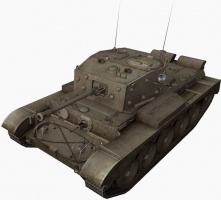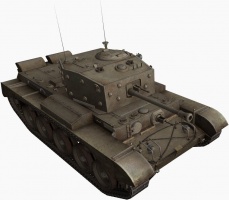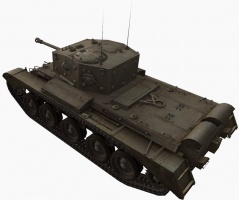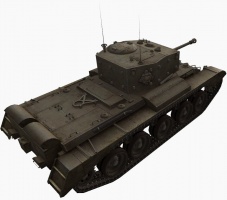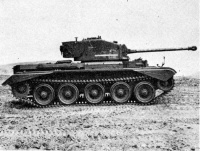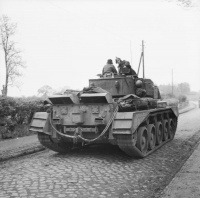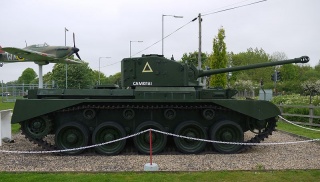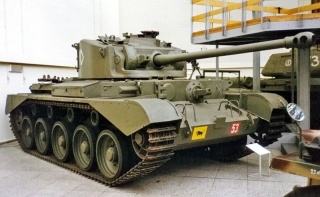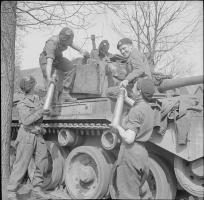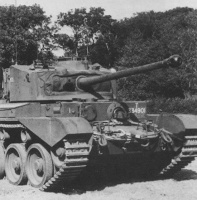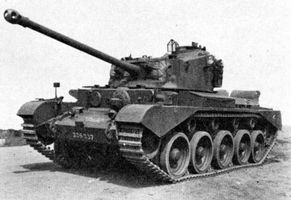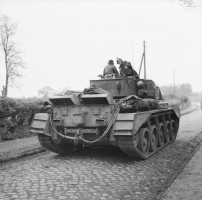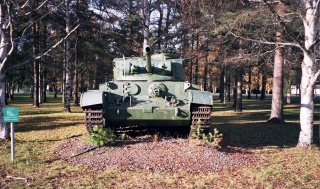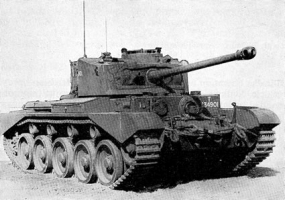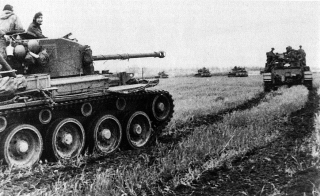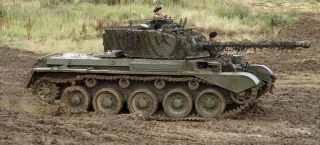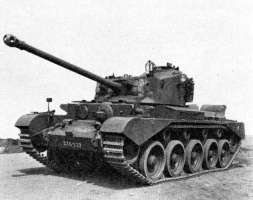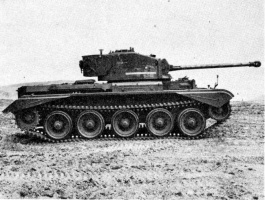Comet
Comet
Mouse over "
| 1,350,500 |
| 1050310 HP Hit Points |
| 30.52/3215.74/34 t Weight Limit |
- 車長
- 炮手
- 駕駛
- 通訊員
- 裝填手
| 600650 hp Engine Power |
| 51.5/18 km/h Speed Limit |
| 3436 deg/s Traverse |
| 19.6641.3 hp/t Power/Wt Ratio |
| NoNo Pivot |
| // mm Hull Armor |
| 76.2/63.5/57.2101.6/63.5/57.2 mm Turret Armor |
AP/APCR/HE
AP/APCR/HE Shells |
| 110/110/175140/140/190 HP Damage |
| 91/144/38148/208/38 mm Penetration |
|
20 r/m ▲
15.38 r/m Standard Gun ▲ Rate of Fire Standard Gun |
|
2200 ▲
Standard Gun
▼
Standard Gun
▲
2153.2 Standard Gun ▲
Standard Gun
▼
Standard Gun
▲ Damage Per Minute Standard Gun |
|
0.41 m ▲
0.34 m With 50% Crew: 0.508 m ▲ Accuracy With 50% Crew: 0.421 m |
| 1.9 s 2.3 s Aim time |
| 4846 deg/s Turret Traverse |
| 360° Gun Arc |
| -13°/+20°-12°/+20° Elevation Arc |
| 7561 rounds Ammo Capacity |
| 2020 % Chance of Fire |
| 360 m 380 m View Range |
| 450 m 700 m Signal Range |
VII
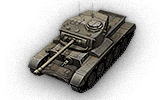
1350500
The Comet is a [[英國|]] tier 7 中型戰車.
Cromwell 巡航戰車的後續研發成品,這輛英國戰車於第二次世界大戰投入服役。從 1944 年 9 月到 1945 年末共製造了 1,186 輛。
The Comet is a tank well suited for flanking, as its armor is neither good nor bad for its class; it won't survive brawls for long periods of time. It sports a couple of advantages over the Cromwell, such as a gun mantlet and lowered profile on the upgraded turret. However, it gets an "almost" inadequate top gun, barely an upgrade over the 75mm HV. What is more, in the footsteps of its predecessor, its handling and speed are somewhat slower, being barely better than those of the Panther and not quite as good as those of the T20. Clever use of flanking tactics and gun depression are necessary to successfully play this tank.
The Comet leads to the Centurion Mk. I.
Modules / Available Equipment and Consumables
Modules

炮管
| 等級 | 炮管 | 平均穿透力(毫米) | 射擊速率 | 100 公尺處擴散度 | 瞄準時間 | 經驗 | 重量 (噸) | 價格, | |
|---|---|---|---|---|---|---|---|---|---|
| V | 3.7-inch Howitzer | 47/110/38 | 370/280/175 | 8.57 | 0.53 | 2.3 | 2300 | 393 | 35000 |
| V | 75 mm Gun Mk. V | 91/144/38 | 110/110/175 | 20 | 0.41 | 1.9 | 0 | 500 | 45000 |
| VI | 75 mm Vickers HV | 145/202/38 | 135/135/175 | 15.38 | 0.36 | 2.3 | 5000 | 591 | 50000 |
| VII | OQF 77 mm Gun Mk. II | 148/208/38 | 140/140/190 | 15.38 | 0.34 | 2.3 | 14500 | 681 | 63000 |

引擎
| 等級 | 引擎 | 引擎功率(匹馬力) | 碰撞時火災發生機率 | 經驗 | 重量 (噸) | 價格, |
|---|---|---|---|---|---|---|
| V | Rolls-Royce Meteor | 600 | 20 | 0 | 744 | 14000 |
| V | Rolls-Royce Meteor Mk. IVB | 650 | 20 | 1900 | 744 | 16000 |

懸吊
| 等級 | 懸吊 | 負載限制 | 迴轉速度(度/秒) | 經驗 | 重量 (噸) | 價格, |
|---|---|---|---|---|---|---|
| VI | A34 | 32 | 34 | 0 | 7000 | 11690 |
| VII | A34A | 34 | 36 | 9100 | 7000 | 18000 |

通訊設備
| 等級 | 通訊設備 | 通訊範圍(公尺) | 經驗 | 重量 (噸) | 價格, |
|---|---|---|---|---|---|
| VII | WS No. 19 Mk. II | 450 | 0 | 40 | 21000 |
| VIII | WS No. 19 Mk. III | 550 | 4000 | 40 | 22000 |
| VIII | WS No. 22 | 700 | 4500 | 40 | 25000 |
Compatible Equipment
Compatible Consumables
Player Opinion
Pros and Cons
Pros:
- Good power to weight ratio
- Decent top speed
- Great gun depression
- Second turret mantlet can give surprise bounces
- Good accuracy on the move with upgraded gun, turret and vertical stabilizer
Cons:
- Weak armour everywhere other than the mantlet
- Inadequate gun damage and penetration
- Sluggish traverse for a medium tank
- High chance of fire if get shot at the rear
Performance
The Comet has a nearly similar playing technique to the Cromwell, although it is not as nimble. It is a mobile medium tank with decent traverse and a good ratio of horsepowers per Ton which allow you to reach high speeds to assist allies. With the new turret with better view range, excellent gun depression, and ability to mount a vertical stabilizer the Comet takes and adapts the good features from the M4A3E8 and the Cromwell into a single tank. However, the gun itself is mediocre for its tier; with only 148mm of penetration, it is outclassed by the T20 and Panther. The OQF 77mm should be used in flanking maneuvers against heavily armored opponents. Where the Comets maneuverability, size and speed give it an easy time getting to enemy flanks. Once in position, its DPM will tear through all but the most durable targets.
Stock, the Comet starts off better than the other Tier 7 mediums, and your upgraded turret allows you to use gun depression tactics with impunity, much like the better American tanks, thanks to your gun mantlet and low profile. It doesn't get much in the way of upgrades though, and ends up significantly weaker in armament for its tier than e.g. the Panther. Still, it is maneuverable, and appears to have fairly good camouflage characteristics. This tank also excels at supporting heavy tanks with its rate of fire. Use this to your advantage at all times.
If you can manage to succeed in - and indeed; actually like the Comet, the upcoming Centurion tank will feel like a whole different world. That world won't be a poor one, it will be a world where you not only dominate hills - but are able to shoot and penetrate most tanks you face from across the map.
Early Research
- The engine, second radio and the 75 mm Viker HV carries from the Cromwell should be mounted immediately. The top radio and the top gun QQF 77 mm MK.II can be carried from the heavy tank line.
- The second research should be the suspension, the tank is too heavy for any upgrade.
- Then research the second turret and the QQF 77 mm gun.
- Last should be the top radio.
Suggested Equipment
Gallery
Historical Info
Combat experience against the Germans in the Western Desert Campaign demonstrated to the British many shortcomings with their cruiser tanks. Hence a request was made in 1941 to the Nuffield Organisation and Leyland Motors Ltd for a new heavy cruiser tank that could achieve battle superiority over German models. For reasons of economy and efficiency, it had to use as many components as possible from the current A15 Cruiser tank Mk VI Crusader tank.
The initial designs submitted were the A24 Cruiser Tank Mk VII Cavalier tank from Nuffield powered by a Nuffield-Liberty L-12 engine and the A27L Cruiser tank Mk VII Centaur tank from Leyland, which was also powered by the Liberty L-12 but would be able to use the more powerful Rolls-Royce Meteor when it became available.
The Cruiser tank Mk VII A27M Cromwell was the third parallel development to the Cavalier and Centaur. The Cromwell's Meteor engine proved to be very reliable and gave the Cromwell good mobility, but some problems did appear. The tank was prone to throwing its tracks if track tension was not maintained properly or if it turned at too high a speed or too sharply. There were also some problems with suspension breakage, partly due to the Cromwell's high speed.
A 17 pounder version of the Cromwell, the A30 Cruiser Mk VIII Challenger tank, was under development. To handle the large gun, the Cromwell hull had to be lengthened and a large turret set on top. Due to the slow production of Challengers, the Sherman Firefly (a Sherman tank fitted with the 17 pounder gun) conversion received official support. Until the Challenger was available, one Firefly would be issued to each Cromwell troop (giving three Cromwells and one Sherman Firefly); but this was unsatisfactory due to the different maintenance requirements and associated supply complication of two tank models, as well as the performance difference between Cromwell and Sherman.
A34
With the A34 (the General Staff specification), later named Comet, the tank designers opted to correct some of the Cromwell's flaws (the track shedding and broken suspension problems) and enhance the Cromwell's main strengths, low height and high speed. Originally, it had been expected that the tank would use a new gun from Vickers: the "High Velocity 75mm". However, as designed, the gun would not fit into the turret size available. So the gun was changed to a different gun, the "77mm HV". This gun used the same calibre (76.2 mm) projectile as the 17-pounder but the shell casing was from the older QF 3 inch 20 cwt gun loaded to higher pressures. The resulting round was completely different to 17-pounder ammunition. It had a lower muzzle velocity than the 17-pounder but the ammunition was much more compact and more easily stored and handled within the tank. This made it possible to mount the gun on a smaller turret ring - the Challenger turret had been so large to allow space for two loaders - without making the hull wider. Several other improvements were made: armour protection was increased, the hull and turret were welded[2] with a cast gun mantlet, ammunition was stored in armoured bins, the suspension was strengthened, return rollers were added and the turret was electrically traversed (a design feature taken from the Churchill tank), with a generator powered by the main engine rather than the hydraulic system of the Cromwell.
Armour on the Comet ranged from 32 mm to 74 mm on the hull, while the turret was from 57 to 102 mm. The Comet tank's top speed was limited from the Cromwell's 40+ mph to a slower, but respectable 32 mph (51 km/h) to preserve suspension and engine components and to reduce track wear. The mild steel prototype was ready in February 1944 and entered trials. Although concerns about the hull gunner and belly armour were put to one side (to avoid redesign), there was still sufficient delay caused by minor modifications and changes that production models did not begin to be delivered until September 1944. Intended to be in service by December 1944, crew training was delayed by the German Ardennes Offensive. By the end of the war, 1,200 had been produced. Comet was fitted with two radio sets: a No. 19 Wireless, for communication with the regiment and the troop, and a No. 38 Wireless for communication with infantry units. Like many British tanks, it also had a telephone handset mounted on the rear so that accompanying infantry could talk to the crew.
Historical Gallery
Sources and External Links
